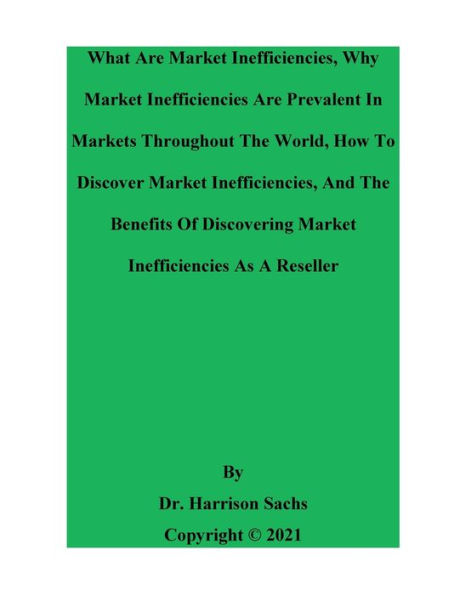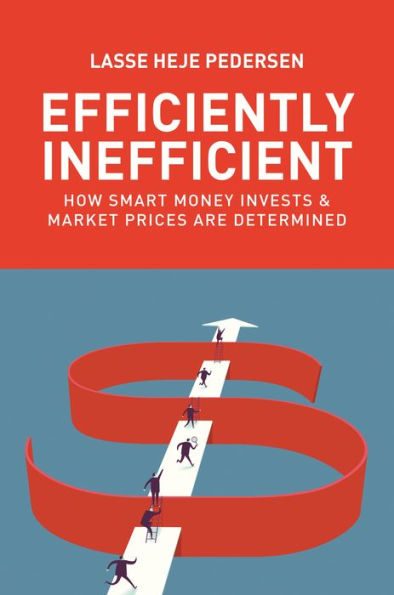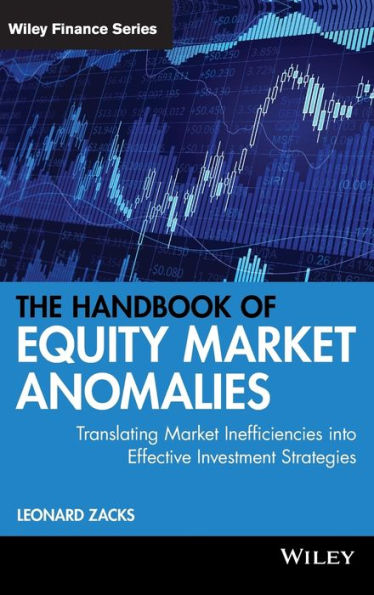Home
What Are Market Inefficiencies, Why Inefficiencies Prevalent, And How To Discover
Barnes and Noble
What Are Market Inefficiencies, Why Inefficiencies Prevalent, And How To Discover
Current price: $21.99


Barnes and Noble
What Are Market Inefficiencies, Why Inefficiencies Prevalent, And How To Discover
Current price: $21.99
Size: Paperback
Loading Inventory...
*Product information may vary - to confirm product availability, pricing, shipping and return information please contact Barnes and Noble
This essay sheds light on what are market inefficiencies, demystifies why market inefficiencies are prevalent in markets throughout the world, explicates how to discover market inefficiencies, and reveals the benefits of discovering market inefficiencies as a resellers. Market inefficiencies transpire when an asset is being sold for a significantly lower price on one market than on another market. Market inefficiencies transpire when the price of an asset on one market does not reflect its true market value and is significantly undervalued on one market relative to its true market value on another market. Market inefficiencies is a phenomenon in which homogeneous assets are priced at significantly different prices in different markets which renders it expensive for customers to buy homogeneous assets in one market and affordable for customers to buy homogeneous assets in another market. Market inefficiencies transpire for a multitude of reasons and are not limited to sellers being acutely unaware of the current second hand value market values of their merchandise. Market inefficiencies can transpire when a seller is eager to immediately liquidate his merchandise in-person and does not want to deal with the hassle of selling his products online via global e-commerce platforms to be able to receive sales revenue that is tantamount to the current second hand market values of his merchandise. Market inefficiencies can transpire even when sellers are acutely aware of the current second hand value market values of their merchandise, but may prefer to not deal with the ample hassles associated with selling his merchandise via online on global e-commerce platforms to be able to receive sales revenue that is tantamount to the current second hand value market values of their merchandise. When you sell products online you have to create listing for the products, package the products, and ship out the products to buyers. Fulfilling online product orders can be highly time consuming and laborious. Sellers may just prefer to sell their merchandise for significantly less than its second hand market values just to not have to deal with the onerous burden of selling merchandise via online on global e-commerce platforms to be able to receive sales revenue that is equivalent to the current second hand value market values of their merchandise. The onerous burden of selling merchandise on global e-commerce platforms to be able to receive sales revenue that is proportional to the current second hand value market values of their merchandise can be a full time job within itself, especially if you have a copious amount of items to sell and would only be willing to sell the items individually if you were going to sell them online via global e-commerce platforms. Selling merchandise in-person for one tenth of its current second hand market values for instance culminates in succumbing to an egregiously high net loss. Succumbing to an egregiously high net loss on the sale of merchandise that has significantly appreciated in value from the date you purchased it can be preempted if you were to simply sell your merchandise that has significantly appreciated in value via online on global e-commerce platforms at their current second hand market values in lieu of liquidating them in-person for one tenth of their second hand market values. Most sellers do not want to sell their merchandise via online on global e-commerce platforms even though doing so would at the very least allow them to be able to receive sales revenue that is commensurate to the current second hand market values of their merchandise. Selling products via online on global e-commerce platforms would be uncharted territory for most sellers to dabble into entering. When market inefficiencies transpire, sellers typically relinquish assets at a net loss and buyers are typically able maximize their buyer surplus. An example of market inefficiencies transpiring entails when buyers procure collectible items at garage sales for one tenth of their second hand market values. A seller may liquidate collectible items at the location of a garage sale for one tenth of their second hand market values since he may be eager to immediately liquidate them in-person without resorting to selling them online via global e-commerce platforms. Market inefficiencies can also transpire when sellers are oblivious to the current second hand market values of their merchandise and do not care to ascertain them. Market inefficiencies are prevalent in markets throughout the world primarily because many sellers are reticent about selling their merchandise online even though selling their merchandise on global e-commerce platforms, such as eBay, is typically the only way to be able to receive sales revenue that is equivalent to the current second hand market values for the merchandise.

















